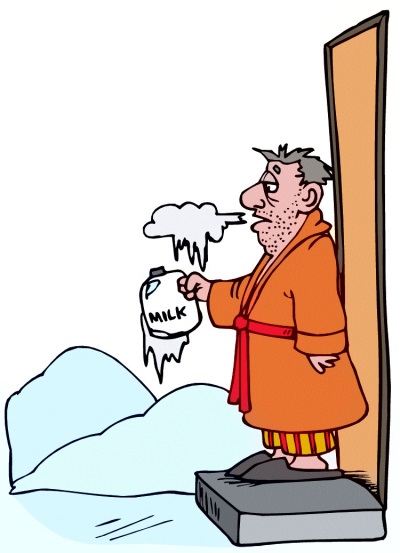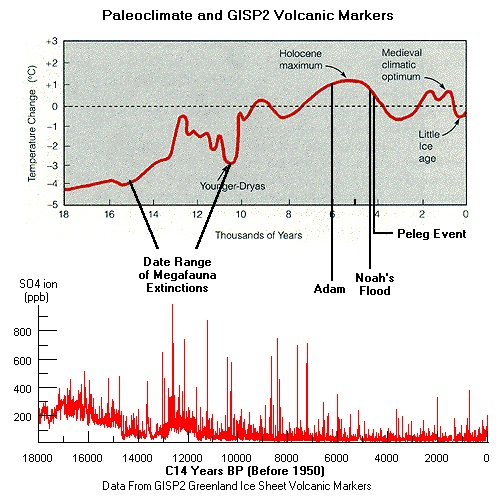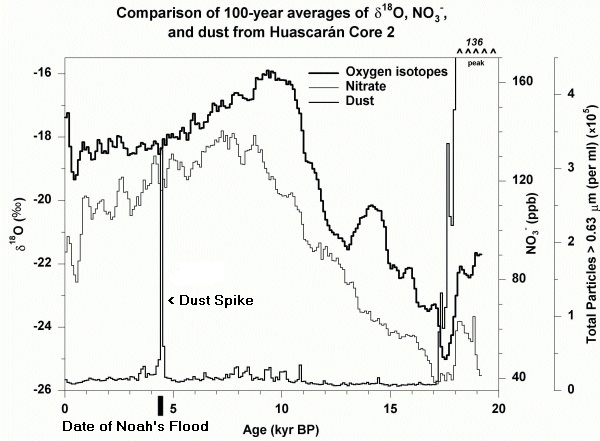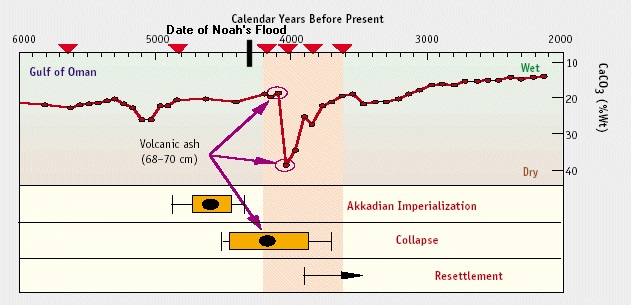Global Dust Spikes, Greenland Ice Sheet, Paleoclimate Indicators and collapse of Civilizations All Correlate to Date of Noah's Flood

In July 1993, the Greenland Ice Sheet Project Two (GISP2) completed drilling down 3,053.44 meters through the ice and 1.55 meters beyond into the underlying bedrock. From this was recovered the deepest ice core record to date. One year earlier the European Greenland Ice Core Project (GRIP) recovered a core to a depth of 3,028.8 meters at a site 30 kilometers east of GISP2. Comparative data between these two deep cores have allowed scientists to develop an ice core-derived paleoenvironmental record dating back greater than 110,000 years BP (BP means "before present" and "BP" is defined as 1950).
The establishment of this 100,000+ year BP record of Earth's atmospheric history in the ice has been fairly well calibrated with proxy dating methods. The annual layer counting of visible ice stratification, when compared to radiocarbon extracted from the CO2 gas trapped within the ice and other measurement techniques, has yielded an age error factor of about 2% from present to 11.64 years BP; about 5% to 17.38 years BP; and 10% to about 40,000 years BP. In other words, the ice has been confirmed to be as old as the collective measurements indicate. These data alone destroy the core doctrine of the theory of Young Earth Creationism that the Earth is only about 6,000 years old.
In addition to the actual age of the ice at any given depth in the core, scientists can also determine the mean temperature of the Earth's past climate for different times and ages by measuring the ratio of the isotopes of oxygen (O16 and O18) gas present in the CO2. Full details of this and other techniques and further references to GISP2 and GRIP projects can be found here: GISP2 Ice Coring Effort.
Secular critics of Young Earth Creationism cite the very existence of the Greenland Ice Sheet and the paleoenvironmental record it contains (as well as the data found in ice cores from the glaciers on Kilimanjaro in Africa and Huascaran in Peru) as absolute proof that the Earth is older than 6,000 years and that Noah's flood did not occur, since there are no indications of a flood in the ice core layers. On the first point they are absolutely correct. On the second point, we disagree that the lack of direct evidence in the ice proves that a global flood did not take place at all. There is certainly much "indirect" evidence to consider and we will detail that on this page.
The ice core records, whether in Greenland or mountain top glaciers around the globe, are replete with "melt" indicators. These are layers where an indeterminate amount of the surface ice has been melted between accumulations. The resolution of the layer dating at GISP2 is about 3.8 years. Therefore, pinning down a one-year flood sequence to definitively prove or disprove Noah's flood in the ice core record is problematic. Whether the ice was floated off its anchor rock by Noah's flood, or remained stuck fast to the rock and was submerged by the flood waters, would make no difference. In either scenario the top layers would have been washed over by fresh (not salt) water, resulting in a "melt" layer or hiatus in accumulation, in the former case by rains; in the latter case through inundation by a rapidly rising fresh water lens. What is important is the fact that the Greenland Ice Sheet and mountain glaciers exist and have calibrated dated layer points between them. We can learn from these if we know what to look for, and where.
If our Bible is true when it tells us Noah's flood was a real and global event that, according to the Biblical chronology, happened about 2,345 B.C. (roughly 4,300 years BP), and if the GISP2 and GRIP data are also true, the only possible explanation is that the bulk of the material which constitutes the basement of the present Greenland Ice Sheet somehow survived that flood. Actually, it would have needed to survive two floods, as the Earth was also flooded before the six-day regeneration. (see Genesis 1:2.) If that is true, the Paleoclimate data from the ice cores can give us insight into environmental conditions, not only after the seven days of Genesis but also before the seven days. What has accumulated on the ice since Noah's flood can tell us about the environment from then until the present.
The top portion of the next graphic shows the global temperature trends across 18,000 years BP, determined by Paleoclimate proxy data. The black lines on the lower left side show where in the time line the last great mass extinction episode took place according to Paleontology. The black lines on the lower right indicate where Biblical history and events fit into the Earth's Paleoclimate record.

(Top-half of composite Graphic base image from
"Meteorology Today" by C. Donald Ahrens 1994 West Publishing Co.)
The bottom half of the graphic shows the GISP2 record for levels of SO4 ions (acid) in the Earth's atmosphere across the same 18,000 years BP. The ion concentrations reflect relative levels of global volcanic activity at given intervals across the time line.
The information on the composite graphic reveals several very important things. From the days of Adam until Noah's flood (Holocene Maximum), the Earth's average temperature was about 1º C higher than in the years after the flood. An average temperature elevation of only 1º will translate into temperatures several degrees warmer in the higher latitudes of the Earth. For what it is worth, even with all the millions of tons of so called "greenhouse gases" that have been added to the atmosphere over the last two centuries, the measured greenhouse effect has so far only increased average global temperatures by less than about half a degree C of what it was before Noah's flood. So it is safe to conclude that the world between Adam and Noah was relatively much warmer compared to our world today.
It should also be pointed out that at the time of Noah's flood (roughly 4,300 years BP), there is no large spike of volcanic markers. This suggests that the Young Earth flood models, all of which are based on suppositions of massive global underwater tectonic and volcanic upheavals, have no basis in fact in the Paleoclimate record. If you will examine the bottom part of the above chart closely you will see that the SO4 ion concentration at 4,300 years BP shows the very lowest levels measured across the entire 18,000 years BP time line. This is in sharp contrast to the heightened volcanic activity on the Earth at the time of the Pleistocene extinctions and through the period immediately before the creation of Adam and the seven days of the Earth's regeneration. This level of volcanic markers is unequaled in the period 6,000 years to present. This volcanic activity was obviously a contributing factor (or a component, at least) to the death of the old world order.
Returning to the graph at the top of the chart, we see the Earth's climate temperature rapidly dropping roughly 1.8º C beginning about 4,300 BP. That is well within the exact time frame for directly after Noah's flood. This would be consistent with a relatively sudden and dramatic climate change, or the introduction of very pronounced yearly weather seasons, or both. The Bible alludes to such a change occurring directly after the flood:
"While the earth remaineth, seedtime and harvest, and cold and heat, and summer and winter, and day and night shall not cease."
(Genesis 8:22 KJV)
What is extremely interesting is that the Greenland Ice Sheet, the Mount Kilimanjaro glacier in Africa, the Huascaran glacier in Peru and even the undersea sediments of the Gulf of Oman, all have anomalous indicators that correlate to around 4,300 to 4,000 years BP. These have been interpreted as markers suggesting extreme climate changes that are theorized to have precipitated the collapse of many ancient civilizations like the Old Kingdom of Egypt and the Akkadian Empire of Mesopotamia.
In these papers on historical environmental extremes, there appears to be a recurring pattern of great drought, abandonment of settlements and delayed reoccupation of the abandoned settlements. For example, review the evidence presented in the paper, "Climate change and the collapse of the Akkadian Empire: Evidence from the deep-sea." Here is another article on the subject entitled "Sea Floor Dust" From these papers you should note the following facts:
1. The time frame, determined by radiocarbon dating, is 4,170 BP +/- 150 cal yrs. That fits the time of Noah's flood (within the dating margin of error).
2. Note the sharp spike in CACO3 and dolomite in the sediments of the Gulf of Oman and their abrupt "spike" date of 4,194 BP. Again, taking the margin of error into account, it fits the post-flood times.
3. Note that the author attributes the sediments in the Gulf of Oman to "dust" blown in from neighboring land areas, thus the conclusion that it indicates a great drought.
4. Note the observation that the settlements remained abandoned for nearly 300 years.
The author of the paper has correctly deduced from the data that a sudden and dramatic climate change occurred, severe drought conditions started, and the settlements were abandoned and all about the time indicated by the radiocarbon measurement of the organic artifacts cited. The author has not identified the cause of climate shift, or proven that the drought caused the abandonment of the settlements, but has made an assumption on the latter based on the evidence and the thesis of the work and the prevailing preoccupation with 'Climate Change' in academia and the media.
Needless to say, the author never even considered the possibility that the cause of the sudden and extreme climate shift may have had something to do with the Biblical Noah's flood.
You ask, "What can a drought and dust possibly have to do with a global flood?" The short answer is: Everything!
Applying the same data to a different thesis, I submit that following a global flood the Earth would have experienced catastrophic drought conditions shortly after the waters abated, and the dust anomaly is evidence of this. It can be argued that it was not the drought that caused the sudden abandonment of the Akkadian Empire settlements - it was Noah's flood that caused it by drowning out the inhabitants. The drought conditions, which would have followed the flood because much of the Earth's vegetation had perished, leaving little or nothing with living root systems to hold the soil down, would be predictable. The settlements would have remained abandoned for many years until the descendants of Noah's family multiplied and began to spread out across the Earth. Eventually they would have migrated back into the area and occupied it when conditions were again favorable for sustaining an agricultural based city-state.
If this were the true scenario, then those climate effects would be almost global and there would be similar climate and dust anomalies elsewhere on Earth corresponding to the same historical time frame. There is just such evidence found in the ice cores extracted from Mount Kilimanjaro in Africa and across the Atlantic in the Huascaran glacier, which is high in the Peruvian Andes of the southern hemisphere.
Below is a graph showing three data sets from the Huascaran glacier. Notice the extremely pronounced dust spike and the time frame, roughly 4.300 years BP (The time of Noah's Flood).

Adapted from chart at:
https://www.ngdc.noaa.gov/paleo/pubs/thompson1995/huascaran.html website.
As you can see, the dust signature found in Huascaran several thousand miles and an ocean away (above chart) from the Gulf of Oman (lower chart), and the common nature of the indicator (dust) and time frame (>4ka), match closely enough within the margin of error to be more than a coincidental correlation.

The data discussed on the following off-site link about the Mount Kilimanjaro Ice Core also show evidence of a dust indicator in the same time frame and suggests that the climate event was connected to the collapse of several ancient civilizations, including the Old Kingdom of Egypt. Additional supporting evidence is found in sediment samples from beneath the waters of Lake Tana, high in the Ethiopian Highlands. This lake feeds the Nile, and the samples reveal the lake may have dried up around 4,200 years ago.
Coincidentally, archeological/astronomical evidence found in the remains of the Old Kingdom of Egypt suggests that the Earth may have also tilted on its axis because of Noah's flood. Physicists say that a flood on the Earth of the magnitude of the Biblical proportions claimed would indeed have caused an axis shift, which would most certainly contribute to global changes in weather patterns. Here is a link to some additional evidence indicating that something happened in 2,345 B.C.
In reference to the temple of Karnak in Egypt in that off-site link, it should also be noted that the time of Noah's flood was about 2,345 B.C. (4,295 years B.P.) Because the temple of Karnak obviously survived the flood, this tells us that the flood was relatively tranquil, drowning out the antediluvian population without wholesale destruction of the relics of those antediluvian civilizations. Certainly that fact alone contradicts all those cataclysmic, hydro-plate sliding, underwater volcano mountain building, Grand Canyon gouging models proposed in most "Creation Science" flood models floating around today. It just did not happen that way.
There is a valid argument, however, concerning the Greenland Ice Sheet and the mountain glaciers which deserves a response: How could the ice have survived Noah's flood? Some claim that if there were such a flood the ice sheet and the mountain glaciers would have floated off from the bedrock and broken up, but the continuity of the ice core record shows no such breakup. Others contend the ice would have remained stuck in place, become submerged, and would contain flood evidence in the ice strata marking the event.
Keep in mind that in either case, a portion of the top layers of ice and snow would have been melted or washed over, leaving no evidence but a indicator of a melt episode or hiatus in accumulation. The renewed new accumulation that followed Noah's flood would only be indicative of post-flood days. The accumulation of the dust spikes previously discussed would be such a post-flood deposition. But could the ice sheet or glaciers remain fast to the Earth and be washed over?
Ice floats, but not under all conditions:
Try this experiment: Take a cupful of ice cubes from your freezer, pour them into a dry metal or stoneware bowl and place the bowl in the freezer for a couple of hours. Then, remove the bowl, set it on the counter, and quickly pour a glass of tap water over the ice inside the bowl. You will find that the ice will remain stuck to the bottom of the bowl, completely submerged under the water until the bowl's surface warms enough to melt the bond. If you transfer this concept to something on the scale of a mountain glacier, it takes an extended period of time for the bedrock to warm or for water to seep under to dissolve a more extensive bond.
The massive Greenland Ice Sheet may be a little different story. Although the fresh water from Noah's flood would certainly be much less buoyant than heavier sea water, meaning less pressure on the ice to float off, the sheer scale of the Ice Sheet could make a stress breakup unavoidable even if the bottom of the sheet was frozen fast to the continent.
At the bottom of the GISP2 bore hole the temperature is -9º C and shows that the ice sheet is frozen tight to the bedrock. From the top of the ice sheet, down to about 2,790 meters, both the GISP2 and GRIP records are nearly identical. Since these two holes are about 30 km apart that indicates that the composition of the ice record is consistent across a large area, or at least between those two holes.
But below 2,790 meters the continuity vanishes. Quoting from a portion of the previously referenced "The GISP2 Ice Core Record - Paleoclimate Highlights" web pages:
"The climatic significance of the deeper part of the GISP2 ice core, below 2790 m depth and 110 kyr age, is a matter of considerable investigation and controversy. The isotopic temperature records and electrical conductivity records of GISP2 and GRIP, so similar for ice <110 kyr in age, are very different in the lower part [ Grootes et al., 1993; Taylor et al., 1993a]. Ice in GISP2 below 2790 m depth is folded and tilted, and shows evidence of unconformities [ Gow et al., 1993]."
This finding of folded and tilted layers and unconformities gives support to the possibility that the massive ice sheet may have been fractured and was lifted off by the global flood of Noah's time, or possibly the earlier flood found at Genesis 1:2. After floating free, the massive sheet would have remained fairly well in the same northern latitudes during such an event, held relatively stationary due to northward-tending currents induced by Earth's Coriolis Force (effect), and very little would have melted. As the flood waters receded, the ice sheet would then gently settle back down and eventually fuse over the submerged ice that had not broken away, because the remaining bottom ice was still frozen solid to the bedrock.
In the next chapter we shift our emphasis away from the Science & Scripture side of the Ruin-Reconstruction and Noah's flood specifics and turn our attention to Theology, Bible Doctrine and Prophecy. Rightly-Dividing these topics, in the context of Genesis and beginnings, will enhance your grasp of their significance and importance to your personal Bible study.
Disclaimer: External Links
from this website are for instructional or promotional purposes and do not
constitute an endorsement
by the The Bible, Genesis & Geology Ministry.
All original text © 1997 -
2021
Gaines R.
Johnson, D.D., D.Th.
The Bible, Genesis & Geology Ministry
Materials from this site may
be freely copied to paper for personal use or church Bible studies.
They may not be reproduced
elsewhere on the Internet, for either personal or commercial use, without
the express written permission of this Ministry.
Are you saved? Are you Sure? Click the image below for the Gospel Truth about the Lord Jesus Christ in your native language!


